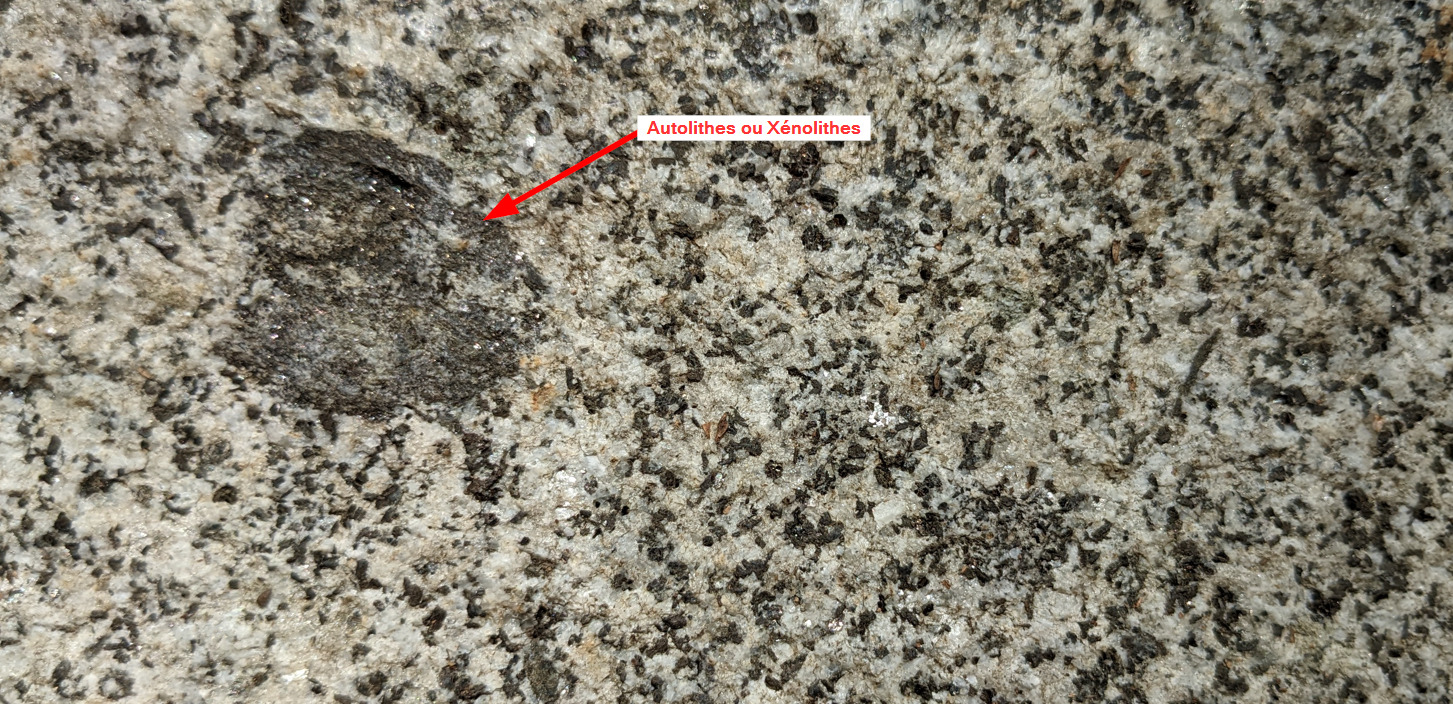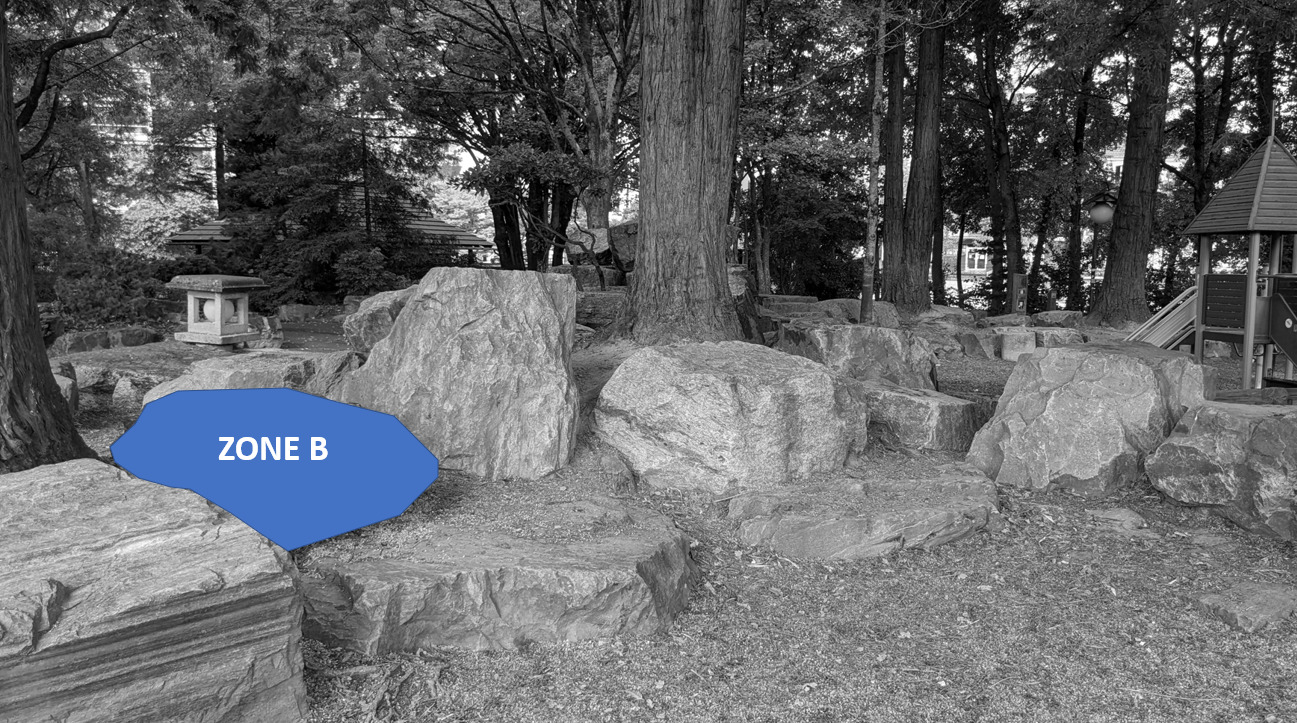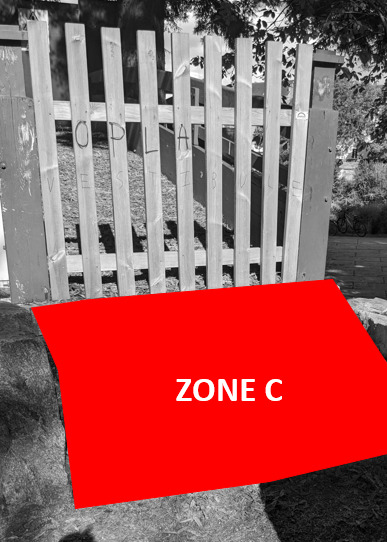
La Earthcache / The Earthcache
L'île Versailles, au coeur de Nantes, a été transformée en Jardin Japonais à la fin du XXième siècle.
Faisant la part belle au règne minéral en cohérence avec la vision philosophique orientale, elle donne donc l'occasion de découvrir quelques roches régionales.
► Micaschite a muscovite
Un micaschiste est une roche métamorphique principalement de minéraux en feuillets.
Cela donne un litage très fin avec un aspect de mille-feuilles.
Certains micaschistes se distinguent par la taille importante des cristaux de mica blanc (muscovite), donnant à la roche un éclat nacré et soyeux qui reflète les rayons du soleil comme un miroir.

► Granite à deux micas
Un granite présente une composition chimique majoritaire de 3 minéraux aux initiales "QFM" :
- Q comme Quartz : translucide parfois transparent, ce minéral est de couleur gris sans facette.
- F comme Feldspath : blanchâtre ou rose, ce minéral est opaque et souvent en macles.
- M comme Mica : noir ou blanc, ce minéral se présente en fines lamelles brillantes.
Le granite a une texture grenue (cristaux visibles) et présente une répartition homogène et non orientée des cristaux avec parfois des enclaves sombres (autolithes ou xénolithes).

► Orthogneiss oeillée de la Ramée
L'orthogneiss est une roche métamorphique issue de la transformation d'un granite. Ces principaux minéraux sont donc similaires au granite :
- Quartz : de petite taille, translucide gris.
- Feldspath (Orthose) : de gros minéraux centimétriques rosâtres et opaques.
- Mica noir (Biotite) : fines paillettes brillantes noires de ferromagnésiens.

Il se distingue du granite par une linéation (structure linéaire apparaissant au sein d'une roche) et le regroupement des minéraux par phase :
- Des lignes claires faites de feldspaths qui se dispersent en lignes parallèles et forment des yeux qui s'allongent dans le sens de l'étirement.
- Des fines lignes sombres de cristaux émiettés de biotite.
Cela donne un gneiss oeillé avec une rubanation (alternance de couches claires et sombres).

Versailles Island, in the heart of Nantes, was transformed into a Japanese Garden at the end of the 20th century.
Giving pride of place to the mineral kingdom in coherence with the Eastern philosophical vision, it therefore gives the opportunity to discover some regional rocks.
► Muscovite micaschite
A mica schist is a metamorphic rock primarily of sheet minerals.
This gives a very fine bedding with a mille-feuille appearance.
Some mica schists are distinguished by the large size of white mica (muscovite) crystals, giving the rock a pearly, silky sheen that reflects the sun's rays like a mirror.
► Two mica granite
A granite has a majority chemical composition of 3 minerals with the initials "QFM":
- Q for Quartz: translucent sometimes transparent, this mineral is gray in color without facets.
- F for Feldspar: whitish or pink, this mineral is opaque and often twinned.
- M for Mica: black or white, this mineral comes in thin shiny strips.
The granite has a grainy texture (visible crystals) and presents a homogeneous and non-oriented distribution of crystals with sometimes dark enclaves (autoliths or xenoliths).
► Eyed orthogneiss
Orthogneiss is a metamorphic rock resulting from the transformation of a granite. These main minerals are therefore similar to granite:
- Quartz: small, translucent gray.
- Feldspar (Orthose): large pinkish and opaque centimetric minerals.
- Black mica (Biotite): fine shiny black flakes of ferromagnesians.
It is distinguished from granite by a lineation (linear structure appearing within a rock) and the grouping of minerals by phase:
- Clear lines made of feldspars that scatter in parallel lines and form eyes that elongate in the direction of stretch.
- Fine dark lines of crumbled biotite crystals.
This gives an eyed gneiss with a banded pattern (alternation of light and dark layers).
► Sources bibliographiques / Bibliographical sources
Les Questions / The Questions
Questions pour valider :"Balade géologique au Jardin Japonais"
Questions to validate: "Geological walk in the Japanese Garden""
Accès soumis à horaires / Access subject to timetables
Horaires du Jardin Japonais de l'île de Versailles.
- Question 0 : Prenez une photo de vous ou d'un élément vous appartenant ou vous le souhaitez dans le Jardin Japonais de l'île Versailles.
Cette photo devra au choix nous être transmise avec les réponses ou être ajoutée à votre log.
-Question 0 : Take a photo of yourself or of an item belonging to you wherever you wish in the Japanese Garden on Versailles Island.
This photo must either be sent to us with the answers or added to your log.
Point 1 : N 47° 13.538 W 001° 33.293'
Si vous venez de l'entrée Sud, une petite sente quitte le chemin sur la droite, avec un Tōrō à promixité (lampe traditionnelle japonaise) - photo WP1.
If you come from the South entrance, a small path leaves the path on the right, with a nearby Tōrō (traditional Japanese lamp) - photo WP1.

- Question 1 : Eclairez la roche avec une lampe , qu'est ce qui vous saute aux yeux ? De quoi s'agit-il ? En observant le reste de la roche, déduisez-en sa nature.
- Question 1: Light up the rock with a lamp, what jumps out at you? What is it about ? By observing the rest of the rock, deduce its nature.
Point 2 : N 47° 13.589 W 001° 33.264'
Vous voici derrière quelques jeux. Utilisez la photo WP2 pour vous repérer.
Here you are behind some games. Use the WP2 photo to get your bearings.

- Question 2 : Décrivez le bloc sous la zone bleue B (taille des éléments, présence de linéation ou pas) et déduisez-en sa nature. Comme se nomme les plus gros éléments ?
- Question 2: Describe the block under the blue zone B (size of the elements, presence of lineation or not) and deduce its nature. What are the largest elements called?
Point 3 : N 47° 13.600 W 001° 33.266'
Grimpez jusqu'au petite portail devant lequel se trouvent quelques marches (photo WP3).
Climb up to the small gate in front of which there are a few steps (photo WP3).

- Question 3 : Décrivez les marches sous la zone rouge C (taille des éléments, présence de linéation ou pas) et déduisez-en leur nature.
- Question 3: Describe the steps under the red zone C (size of the elements, presence of lineation or not) and deduce their nature.
Vous pouvez vous loguer sans attendre notre confirmation,
mais vous devez nous envoyer les réponses en même temps soit par mail via notre profil (
fafahakkai), soit via la messagerie geocaching.com (Message Center).
S'il y a des problèmes avec vos réponses nous vous en ferons part.
Les logs enregistrés sans réponse seront supprimés.You can log this cache without waiting for our confirmation, but you must send us the answers at the same time, by e-mail via our profile (fafahakkai) or by the system of Message Center of geocaching.com.
If there is a problem with your answers we will notify you. The logs recorded without answers will be deleted.
Rappel concernant les « Earthcaches »: Il n'y a pas de conteneur à rechercher ni de logbook à renseigner. Il suffit de se rendre sur les lieux, de répondre aux questions ci-dessus et de nous renvoyer les réponses.
Reminder concerning "Earthcaches": there is neither a container to look for nor a logbook to sign. One need only go to the location, answer to the differents questions and send us the answers.